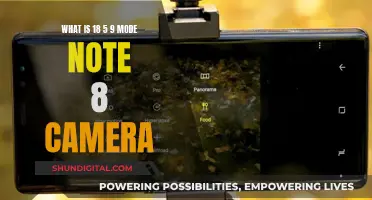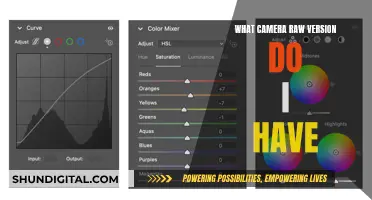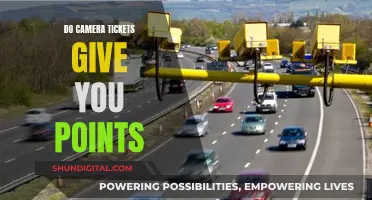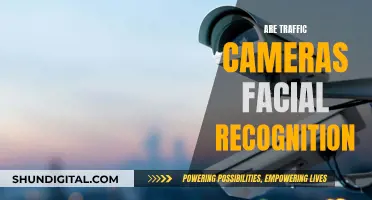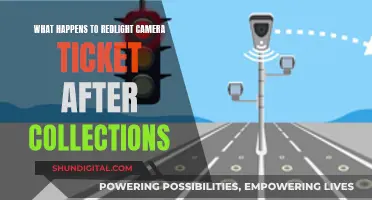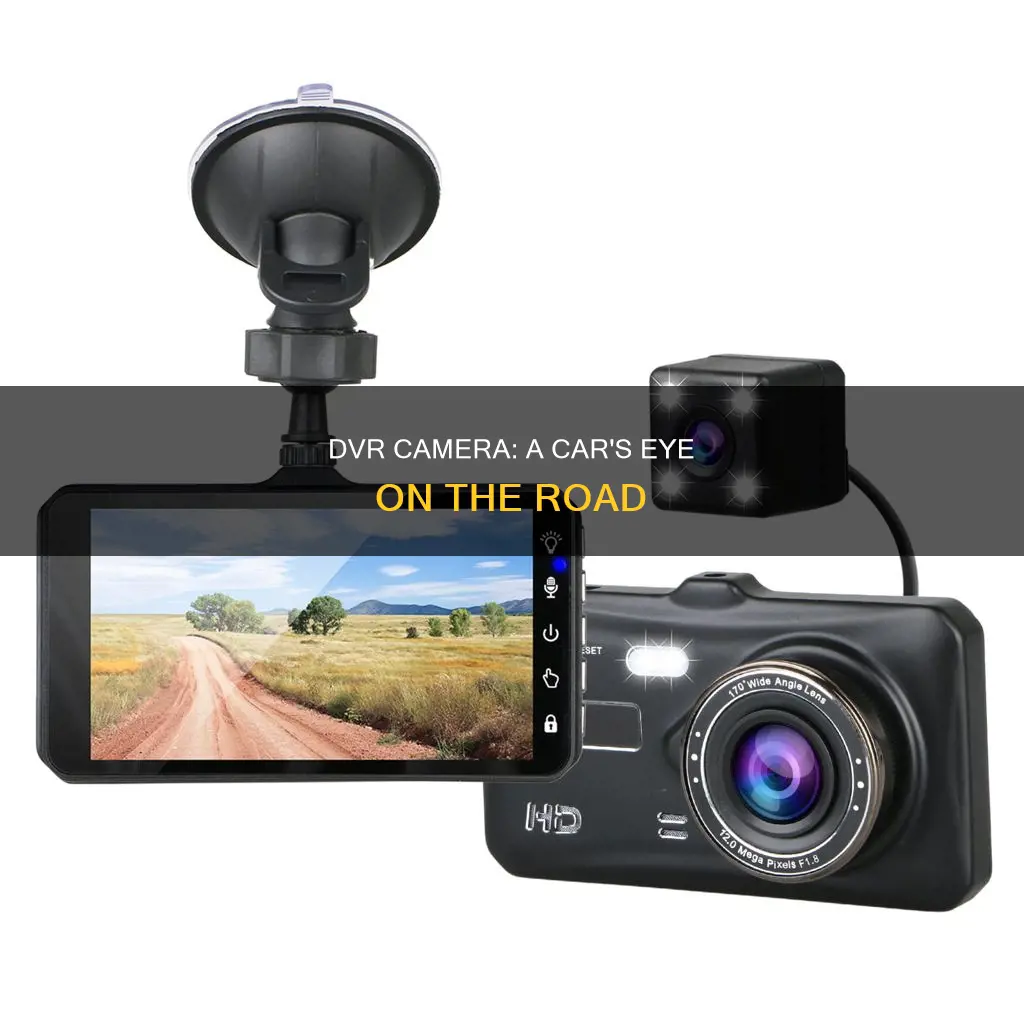
A car DVR camera, or dashboard camera, is a device that can be mounted on the windscreen or dashboard of a car, recording the view through the front windscreen and sometimes the rear or other windows. The footage from a car DVR camera can be used as evidence in the event of an accident or insurance claim, and can also help to monitor young or unsafe drivers. The cameras are usually powered via the cigarette lighter cable or can be hardwired into the fuse box, and footage is stored on a micro SD card.
| Characteristics | Values |
|---|---|
| Purpose | Records sounds and images while driving |
| Placement | Mounted on the dashboard or the windscreen of the car |
| Operation | Automatically switches on and starts recording when the car's ignition is turned on |
| Storage | Recorded video files are stored on an SD card or internal storage |
| Loop Recording | Automatically deletes old files and replaces them with new files to ensure continuous recording |
| Video Capturing Capability | Equipped with a wide-angle lens to capture the full width of the road and surroundings |
| Dual-Lens | Some dash cams have a dual-lens to capture the interior of the car in addition to the front view |
| GPS Tracking | Includes a GPS tracker to log the speed and location of the vehicle |
| G-Sensor | Detects collisions or movements and triggers the camera to start recording |
| Night Vision | Capable of recording in low-light or dark conditions |
| Wi-Fi and Bluetooth Connectivity | Allows for remote control and data transfer to smartphones or other devices |
| Resolution | Typically offers 1080p or higher resolution for clear and detailed recordings |
What You'll Learn

Evidence in case of an accident
A car DVR camera, or dashcam, is a device that can be mounted on your vehicle's dashboard or windscreen to record everything that takes place on the road. In the event of an accident, a car DVR camera can be a valuable tool for gathering evidence and determining fault. Here are some reasons why a car DVR camera is essential for gathering evidence in case of an accident:
Objective Evidence
A car DVR camera provides an unbiased record of events, capturing the view through the vehicle's front windscreen and sometimes the rear or other windows. This objective evidence can be crucial in reconstructing the accident, as it accurately depicts the sequence of events leading up to the incident.
Accurate Timeline
The footage from a car DVR camera can pinpoint the exact time of an accident, which is essential for establishing a clear timeline of events. This information can be vital for insurance claims and legal proceedings.
Visual Details
Car DVR cameras can capture important visual details that human observers might miss or forget. This includes traffic light colours, vehicle speeds, road conditions, and the presence of any obstructions or distractions. These details can be crucial in determining liability and understanding the cause of the accident.
Identification
In hit-and-run cases, a car DVR camera can be invaluable for identifying vehicles, drivers, and other parties involved. The footage can provide clear evidence of the involved vehicles' make, model, and license plate numbers, increasing the chances of locating the responsible parties.
Corroboration
The footage from a car DVR camera can support or refute statements made by drivers and witnesses. This corroboration helps in determining the accuracy of testimonies and can reveal any inconsistencies or false claims.
Clarity in Complex Scenarios
Accidents involving multiple vehicles or complicated circumstances can be challenging to untangle. A car DVR camera provides a clear record of the chain of events, helping investigators and insurance companies understand the sequence of events and identify any contributing factors.
Reporting Reckless Driving
In many countries, aggressive or rash driving is a significant concern. With a car DVR camera, you can record and report such drivers to the relevant authorities. The footage can serve as evidence of reckless driving behaviour, helping to hold these drivers accountable and make the roads safer for everyone.
Samsung S5 Camera Focus: Poor Performance, Why?
You may want to see also

Preventing insurance fraud
A car DVR (digital video recorder) camera, also known as a dashcam, is a small camera that is mounted on a car's dashboard or windscreen. It continuously records the view through the front windscreen and sometimes the rear or other windows. Some dashcams also have a 360-degree interior camera. The recorded video files are stored on an SD card or internal memory and can be used as evidence in the event of accidents or insurance fraud.
Car DVR cameras are an effective tool for preventing insurance fraud and protecting yourself from false allegations. Here's how they can help:
- Evidence and Accident Reconstruction: Dashcams provide unbiased visual evidence of what happened before, during, and after an accident. This can help prove your innocence and protect you from fraudulent accident claims or false allegations by other drivers or pedestrians attempting insurance fraud.
- Fraud Detection: With a dashcam, you can capture incidents of fraud or scam attempts. For example, capturing a staged accident or someone purposely causing a collision to extort money. This evidence can help you avoid harassment and false claims.
- Accurate Fault Determination: The video footage from a dashcam can be crucial in determining who was at fault for an accident. It can help insurance companies and law enforcement officers accurately assign fault, which is essential for insurance claims and preventing fraud.
- Improved Driving Skills: Reviewing dashcam footage can help you identify areas for improvement and correct errors. This can lead to safer driving habits and reduce the risk of accidents, lowering your insurance premiums over time.
- Parking Surveillance: Many dashcams have parking surveillance features that can record incidents when your vehicle is parked, such as hit-and-run incidents or vandalism. This can help identify perpetrators and protect you from false claims.
- Data and GPS Information: In addition to video footage, dashcams often record data such as acceleration, deceleration, g-force, speed, steering angle, and GPS location. This data can provide valuable context for insurance claims and help detect fraud by corroborating or contradicting statements made by those involved.
- Reducing He-Said/She-Said Scenarios: Dashcam footage can provide clear evidence in situations where there are conflicting accounts of an incident. This can help resolve disputes quickly and fairly, reducing the potential for insurance fraud.
Knowing Your Camera's Focus: A Quick Guide
You may want to see also

Capturing road trips
A car digital video recorder (car DVR) or dashcam is a camera that can be mounted on your dashboard or windscreen to record your drive. They can be useful for road trips as they can capture unforgettable moments and incidents, which can be shared on social media or used as evidence in the event of an accident.
When choosing a dashcam for a road trip, it's important to consider the video quality, field of view, and storage capacity. Look for a camera that records in at least 1080p full HD resolution and has a wide-angle lens to capture more of the scenery and surroundings. A dashcam with loop recording is also useful, as it automatically deletes old files to make space for new ones.
Additional features to look for include GPS tracking, which allows you to track your route and revisit landmarks, and an LCD screen, which makes it easier to adjust camera settings. Smart features such as app or cloud connectivity, Bluetooth, and voice control can also enhance your experience.
- Mount your camera securely: Ensure your camera is mounted securely and positioned to capture the desired view. The placement of the camera will depend on the type of vehicle and your preferences. Some common mounting options include the interior windscreen, rear-view mirror, or dashboard.
- Consider the lighting and surroundings: Adjust the camera settings to ensure you're capturing the best footage, especially when dealing with varying lighting conditions throughout your road trip.
- Capture a mix of scenery and driving footage: A road trip isn't just about the destinations; it's also about the journey. Capture a mix of footage, including the winding roads, unique city architecture, and any interesting landmarks you encounter.
- Use accessories to enhance your footage: Consider using accessories such as a tripod, external flashes, or different lenses to enhance your footage, especially if you plan to do any still photography during your trip.
- Be mindful of local laws: Remember to check the local laws regarding the use of dashcams and mounting items on your windshield. Some states and countries have specific restrictions to ensure that your dashcam doesn't obstruct your view or violate privacy laws.
- Capture the journey, not just the destination: A road trip is about the entire experience, so make sure to capture not only the scenic destinations but also the moments along the way. This could include interactions with locals, interesting roadside attractions, or even just enjoying a meal at a unique diner.
- Tell a story with your footage: When capturing your road trip, try to tell a story with your footage. This could be the story of your journey, the people you meet, or the places you visit. Adding context and a narrative arc to your footage will make it more engaging for others to watch.
- Edit and share your footage: After your road trip, take the time to review and edit your footage. You can use video editing software to create a compelling video that showcases the highlights of your trip. Share your video with friends, family, or even online to inspire others to embark on similar adventures.
- Capture the details: Pay attention to the small details that make your road trip unique. This could include interesting road signs, license plates from different states or countries, unique snacks or gas station finds, or even just the odometer as the miles tick by. These little details can add a sense of charm and personality to your footage.
- Don't forget the audio: While the visual aspect of your road trip is important, don't neglect the audio. Try to capture the sounds of the road, whether it's the rumble of your engine, the wind rushing by, or conversations with your travel companions. These audio elements can add depth and immersion to your final video.
Infrared Photography: IR Mode Camera Settings
You may want to see also

Monitoring young drivers
A car DVR camera, or dashboard camera, is a device that is mounted on the windscreen or dashboard of a car. It records the view through the front windscreen and sometimes the rear or other windows. Some car DVR cameras also have a camera to record the interior of the car.
Car DVR cameras can be useful for monitoring young drivers. The latest dashboard cameras can live stream the feed to your smartphone, allowing you to evaluate their driving style. This can be particularly useful if you are worried about the driving style of your younger family members.
In addition to monitoring young drivers, car DVR cameras offer several other benefits. They can provide evidence in the event of an accident, reduce road rage by providing video proof of incidents, and help report reckless or rash drivers. They can also help avoid harassment from police and capture unforgettable moments during daily drives.
When choosing a car DVR camera, consider factors such as video resolution, field of view, storage capacity, connectivity options, and the inclusion of features like GPS tracking and loop recording.
While car DVR cameras offer many advantages, it's important to be aware of potential privacy concerns associated with their use.
Lumix Cameras: Post-Focus Feature Availability and Compatibility
You may want to see also

Parking mode
There are several types of parking modes, and not all dash cams offer this feature. Some common types of parking modes include:
- Simple parking mode: The camera will start recording when motion or an impact is detected. This type of mode consumes less energy but may not capture the perpetrator as it takes time for the camera to start recording.
- Buffered parking mode: The camera records continuously and saves footage to its memory. When an impact or motion is detected, a video clip is saved to the SD card, including footage from before and after the event.
- Time-lapse mode: The camera takes a still picture every second or so, creating a time-lapse of what happened while you were away.
- Low bit rate mode: The camera runs continuously but records at a lower video quality or resolution. This mode is not recommended as it may be difficult to identify license plates in the event of a hit-and-run.
- Radar parking mode: An advanced type of parking mode that is more energy-efficient than buffered parking mode. It records a buffered video when an impact is detected or a normal video when a person is detected near the car.
To use parking mode, you will need to connect your dash cam to your vehicle's battery or use a battery pack to power the camera when the engine is off. Hardwire kits and OBD-II power cables are common ways to connect the dash cam to the vehicle's battery. Alternatively, you can use a dash cam battery pack, which can be plugged into the cigarette lighter socket or hardwired to the vehicle battery.
The Yashica YK Camera: A Historical Timeline
You may want to see also
Frequently asked questions
A car DVR camera, or dashboard camera, is a device that is mounted on the windscreen or dashboard of a car. It records the view through the front windscreen and sometimes the rear or other windows.
The purpose of a car DVR camera is to act as a "silent witness" in the event of accidents, providing an unbiased record of what happened. This can help protect drivers from hit-and-runs, vehicle accidents, and insurance fraud.
A car DVR camera is powered via the cigarette lighter cable or can be hardwired into the fuse box. It starts recording automatically when the ignition key is turned on and saves footage onto a micro SD card.
Using a car DVR camera is legal in some countries, such as the UK, as long as it does not restrict the driver's view and is not used to intrude upon someone's privacy. However, the legality may vary depending on the country and local laws.
Some benefits of using a car DVR camera include having evidence in case of an accident, reducing road rage, reporting reckless or rash drivers, avoiding harassment from police, and capturing unforgettable incidents or road trips.



